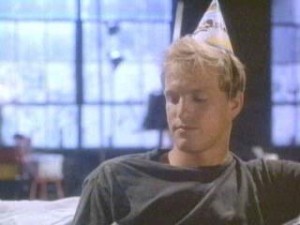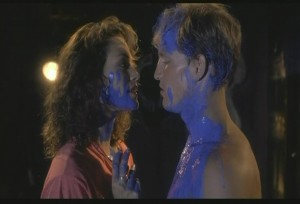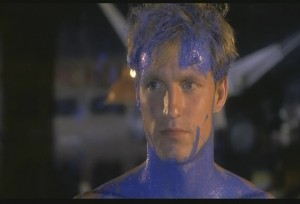Cool Blue
 It used to take a lot of effort for a star vehicle to go straight to video, especially during the late 1980’s, at the height of VHS’s popularity. Cool Blue probably seemed like an ideal low-budget project for Woody Harrelson, where he could stretch by playing the struggling artist, but also cater to his fans with the unassuming farmboy look and romantic entanglements. But that’s even more than what we actually get, because Harrelson’s character is actually an LA cityboy and the woman he becomes obsessed with is someone who he has nothing in common, nor does she make much sense.
It used to take a lot of effort for a star vehicle to go straight to video, especially during the late 1980’s, at the height of VHS’s popularity. Cool Blue probably seemed like an ideal low-budget project for Woody Harrelson, where he could stretch by playing the struggling artist, but also cater to his fans with the unassuming farmboy look and romantic entanglements. But that’s even more than what we actually get, because Harrelson’s character is actually an LA cityboy and the woman he becomes obsessed with is someone who he has nothing in common, nor does she make much sense.
Ely Pouget is the love interest, which we know right away because of the rule of nude scene innocence in 80’s films. The woman with the small breasts is always the right girl, the one with large breasts (which apparently equals slutty) is the right now girl. Writer-director Richard Shepard (The Matador, The Hunting Party) gives Pouget a totally inconsistent and unplayable character and so while we find out that she’s some sort of slick thief and/or a drug dealer, who is also into art (and art galleries run by way over the top queens), she’s also a soft, gentle, flaky romantic, just trying to get away from her abusive [ex?] husband. John Diehl plays the husband, and mostly he yells and screams about her ruining his life and his nefarious unnamed business. It is implied he is a criminal, but an in-home business dinner with two well-dressed and conservative men means it could have been anything. He could have been a Q-Tip broker for all we know.
 Diehl’s role accentuates the method that both Shepard and the actors use, long, rambling, shapeless improvisations that don’t go anywhere or make sense, but there’s sure a lot of yelling. Hank Azaria, playing Harrelson’s best friend gets the worst of it, because he has two or three different speeches that are totally at odds with each other (clearly, this movie is a tonal mess). And when Azaria uses the script, he has to deal with mouthfuls of unutterable dialogue (“these are the celestial cockteasers of your imagination”) that either suggests he’s a drunk, an idiot, a desperately lonely man, jealous of his friend, brilliantly witty and insightful, a slick go-getter, or just the liar who writes for Screw Magazine. Azaria probably would have preferred the movie to be just an acting exercise, as opposed to someone actually filming. In any given scene, he’s either exactly right in his choices, or laughably awful.
Diehl’s role accentuates the method that both Shepard and the actors use, long, rambling, shapeless improvisations that don’t go anywhere or make sense, but there’s sure a lot of yelling. Hank Azaria, playing Harrelson’s best friend gets the worst of it, because he has two or three different speeches that are totally at odds with each other (clearly, this movie is a tonal mess). And when Azaria uses the script, he has to deal with mouthfuls of unutterable dialogue (“these are the celestial cockteasers of your imagination”) that either suggests he’s a drunk, an idiot, a desperately lonely man, jealous of his friend, brilliantly witty and insightful, a slick go-getter, or just the liar who writes for Screw Magazine. Azaria probably would have preferred the movie to be just an acting exercise, as opposed to someone actually filming. In any given scene, he’s either exactly right in his choices, or laughably awful.
Obviously, this is an aimless, bad film, but it is something to be seen, at least as a mix of pretentious brooding and what passed for hip/clichés (and art vs. commerce arguments) in the time period. And that doesn’t even get to Sean Penn’s cameo as… Maybe he’s playing a drunken version of the leprechaun who guards Lucky Charms? In that case, they probably should have changed from the Diet Pepsi product placement deal.
 Also, I have no idea what the title is supposed to mean. Perhaps it referred to this?
Also, I have no idea what the title is supposed to mean. Perhaps it referred to this?



